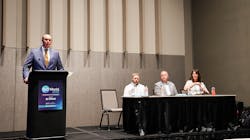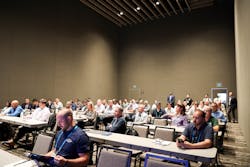Planning the Power Grid of the Future at T&D World Live
We set goals for renewables, net zero energy and carbon free energy. These resource related goals will require a 21st century distribution grid that is reliable, resilient and still affordable. Will it be our grandfather’s distribution grid? No.
The electric distribution grid of the future will be a modern, integrated grid that accommodates distributed energy resources like rooftop solar, fuel cells, storage, and vehicle to grid electric vehicles (EV). This increasingly complex grid that delivers the clean electricity that we need for our future will be fundamentally transformed into a new and dynamic technological wonder.
Underground electric distribution lines will be an important part of that transformation. Therefore, as we set ambitious goals for clean electricity, we need to do the same for the distribution grid that delivers that electricity.The “50% Underground by 2040” panel had standing room only for Pacific Gas & Electric’s Matt Pender, Exelon Transmission’s Joe Svachula, and Anaheim Public Utilities’ Janet Lonneker.
At the panel, I reminded our audience that the industry sets many goals related to carbon, net zero energy, renewable integration and electrification of transportation. But whether we achieve 40% underground by 2050 or 50% underground by 2040, the industry benefits from the discussion and debate.
What did we learn at T&D World Live?
Anaheim Public Utilities
Anaheim has a 4% electric rate surcharge that has funded their major 12kV underground program for the last 35 years. Today they collect nearly $14 million per year for undergrounding. They have enhanced the beauty of their community and improved system reliability by 30% for big customers like Disneyland and the Anaheim Angels baseball stadium. They are 60% underground and 30% of that is direct bury. Anaheim has an underground gas insulated switchgear (GIS) substation built beneath a city park as well.
Initially, the cost of urban underground at Anaheim was approximately $2 million a mile. Today, with decades of inflation, that cost is more around $7 million a mile. Getting easements for underground equipment takes time and close customer coordination is required. Easement acquisition is typically the longest delay for a project.
Coordination with other utilities is important especially since Anaheim has a 3-year moratorium on cutting the street (pavement) after new work is completed. Anaheim Public Utilities has arranged a cost sharing program with local communications companies, said Lonneker.
“Funding sources for undergrounding in Anaheim include a 4% surcharge on customer electric bills, a wildfire mitigation grant through FEMA. We are also seeking grant funding opportunities through the Infrastructure Investment and Jobs Act offered through the U.S. Department of Energy,” Lonneker said.
“The cost to underground electric lines in densely populated urban areas can be 2-3 times more than in rural areas because we’re competing for space under streets where all other utilities such as water, gas, and communications are located. Each require a minimum separation in the trenches to maintain safety. In some instances, we need to work with property owners because the public space is full.”
Lonneker said she wishes that they had done more underground earlier. She said reliability has improved 30%, but when outages do occur, they take longer to repair ranging typically from 10 to 24 hours. But, in general, over the 50-year life that Anaheim assigns to their new underground distribution, underground has a lower cost of ownership.
Pacific Gas & Electric
CEO Patti Poppe has said they are rebuilding PG&E from the “underground up.”
Matt Pender confirmed that ambitious goal and said that PG&E will spend $30 billion to underground the first 10% of its T&D system. Undergrounding existing overhead lines will be prioritized for the areas most susceptible and at-risk to wildfire damage. It plans to have 3600 miles of line placed underground by 2026 and will then be one-third of the way to its 10,000 mile goal. PG&E seeks innovative ideas from the industry and actively looks for ways to implement that innovation in its program. Some of those participants were in the audience.
“PG&E strongly believes that undergrounding electric distribution lines in high fire-risk areas is the most effective long-term solution for keeping customers and communities safe amid increased wildfire risk and longer wildfire seasons across the Western United States. Undergrounding essentially eliminates wildfire ignition risk from those lines and helps reduce long-term operations and maintenance costs. That is why we’ve begun a journey to underground 10,000 miles of distribution lines in high wildfire risk areas,” according to a statement by PG&E.
“To deliver on our 10,000-mile plan as efficiently as possible PG&E is leveraging the best techniques, methods and technologies to plan, design, construct and energize underground lines. We are using the tools we have and have engaged with industry experts, startups, academics and others through venues like our Innovation Summit in July and Pitch Fest in September to gather new approaches for challenges like mapping existing subsurface infrastructure, boring through hard rock and managing the dirt that comes out of the ground as efficiently as possible,” according to PG&E.
While PG&E may not achieve 50% of its distribution system undergrounded by 2040, the utility is working at an unprecedented rate to reduce wildfire risk and deliver a system that is more resilient and cost-effective for our communities in the long term.
Today, PG&E has 27% underground distribution and 1% underground transmission. When PG&E completes its $30 billion, 10,000-mile underground distribution program, it will have 37% undergrounded.
Current PG&E experience is that 70% of the capital cost of an underground line is civil construction like trenching, boring, conduit and manhole placement, backfill and right of way/street repair. It has determined that the initial capital cost of undergrounding is about three times more expensive than similar voltage overhead distribution but when projected over the 49-year life of the asset the net present value of underground proves to be more cost effective. It currently had a three-year maintenance cycle for underground.
PG&E has put about 300 miles of distribution line underground this year toward its annual goal of 1000 miles per year. It has much to do.
Exelon Transmission
Exelon has major High-Pressure Fluid Filled (HPFF) transmission lines in Chicago, Philadelphia, Baltimore and Washington, D.C. It needs to replace the antiquated HPFF with solid di-electric cables and have a segment of super conductors installed between two downtown Chicago substations.
Joe Svachula, senior vice president of Transmission & Compliance at Exelon Utilities said, “Undergrounding Transmission is a powerful tool for our engineers and although it increases resiliency it can also be very expensive. The new underground systems also reduce maintenance allowing us deploy additional capital. We also continue to evaluate the application of emerging technologies such as advanced high temperature low sag conductors, dynamic line rating equipment and superconductors.”
Exelon is interested in the lower cost of operations and maintenance (O&M) of its underground transmission systems because for every dollar of O&M saved, it frees up seven dollars for capital expenditures to improve and expand the system.
Conclusion
Today, the electric distribution system in America is approximately 20% underground. Some public power utilities like Ft. Collins, Colorado Springs, and Anaheim have had underground ordinances for years. They have beautified their cities and improved the performance of their systems. Fort Collins is 99% underground and is 99.9% reliable. Colorado Springs started in the 1970s and today is 77% underground with 99.9% reliability.
They estimate they can be all underground with another $2.2 billion investment. Colorado Springs overhead transmission line with underground distribution Anaheim has been engaged in their Home Underground Program (HUG) since 1990 with excellent results. And, the phone and cable TV utilities in Anaheim paid to go underground as well.
Investor-owned utilities have put new neighborhoods underground for years, and now, many large IOU’s like PG&E, FP&L, WEC Energy Group and Dominion are engaged in multi-year, multi-billion dollar programs to “strategically” underground laterals and other key parts of their systems.
Undergrounding the electric distribution grid provides a compelling solution to enhanced system reliability and resiliency, especially as we strive to achieve net-zero energy and carbon-free generation goals.
The many benefits of a 21st century underground electric grid include dramatically reducing weather and vegetation related outages, improving resilience to natural disasters, and delivering long-term value over the life of the asset, make it an important component of a modernized and sustainable energy infrastructure.
The integration of massive electrification and more distributed energy resources with an underground electric distribution grid will help us to potentially meet or exceed our clean energy objectives and create a safer, more affordable and environmentally conscious energy system for the future.
And, like PG&E’s Matt Pender said as he concluded, “Maybe we will achieve 50% by 2040.”
Mike Beehler ([email protected]) has over 40 years of electric transmission and distribution experience at Tucson Electric Power, Hawaiian Electric Company and Burns & McDonnell. He was educated as a civil/structural engineer at the University of Arizona and is a registered professional engineer in eight states including Hawaii. He currently is the founding member and Chief Opportunity Officer of Mike Beehler & Associates, LLC and serves as the National Spokesperson for the Power Delivery Intelligence Initiative https://www.pdi2.org/. Beehler is a Fellow in ASCE and a Member
of CIGRE and IEEE.
About the Author
Mike Beehler
Vice President
Mike Beehler P.E., ([email protected] ), is the national spokesperson for the Power Delivery Intelligence Initiative and the chief opportunity officer for Mike Beehler & Associates LLC. He started his career designing and building transmission lines and substations for Tucson Electric Power and the Hawaiian Electric Co. and then spent more than 20 years designing T&D infrastructure and consulting on emerging trends at Burns & McDonnell. He has written, presented and consulted on reliability-centered maintenance, critical infrastructure protection and program management. In addition, he is a well-known industry writer and speaker on the early definition of the smart grid, 3-D and building information modeling applications in T&D, and development plans for smart cities. Most recently, he is sought for his strategic leadership and vision on the application of emerging technologies in changing business models to include the integration of distributed energy resources, augmented/virtual reality and artificial intelligence. He authored the book, The Science of the Sale. Beehler is a registered professional engineer in Arizona, Florida, Hawaii, Texas, Colorado, Kansas, Georgia and Alabama. He also is a Fellow in the American Society of Civil Engineers and a member of IEEE and CIGRE.

